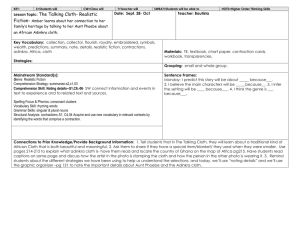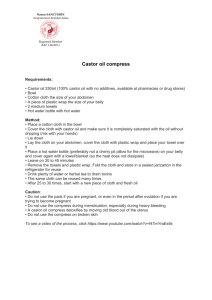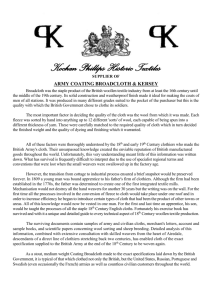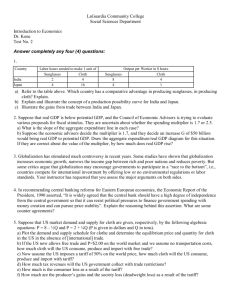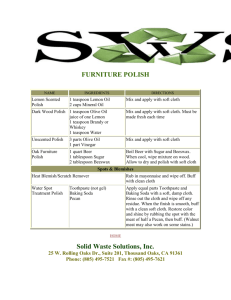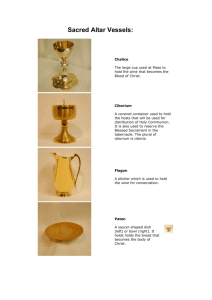African_Textiles_Unit_Plan_Lesson_3__Day_3
advertisement
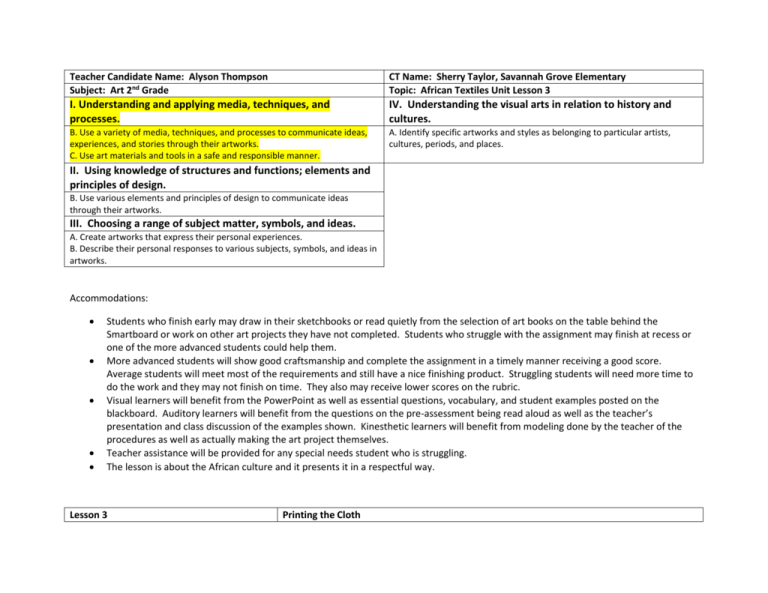
Teacher Candidate Name: Alyson Thompson Subject: Art 2nd Grade CT Name: Sherry Taylor, Savannah Grove Elementary Topic: African Textiles Unit Lesson 3 I. Understanding and applying media, techniques, and processes. IV. Understanding the visual arts in relation to history and cultures. B. Use a variety of media, techniques, and processes to communicate ideas, experiences, and stories through their artworks. C. Use art materials and tools in a safe and responsible manner. A. Identify specific artworks and styles as belonging to particular artists, cultures, periods, and places. II. Using knowledge of structures and functions; elements and principles of design. B. Use various elements and principles of design to communicate ideas through their artworks. III. Choosing a range of subject matter, symbols, and ideas. A. Create artworks that express their personal experiences. B. Describe their personal responses to various subjects, symbols, and ideas in artworks. Accommodations: Students who finish early may draw in their sketchbooks or read quietly from the selection of art books on the table behind the Smartboard or work on other art projects they have not completed. Students who struggle with the assignment may finish at recess or one of the more advanced students could help them. More advanced students will show good craftsmanship and complete the assignment in a timely manner receiving a good score. Average students will meet most of the requirements and still have a nice finishing product. Struggling students will need more time to do the work and they may not finish on time. They also may receive lower scores on the rubric. Visual learners will benefit from the PowerPoint as well as essential questions, vocabulary, and student examples posted on the blackboard. Auditory learners will benefit from the questions on the pre-assessment being read aloud as well as the teacher’s presentation and class discussion of the examples shown. Kinesthetic learners will benefit from modeling done by the teacher of the procedures as well as actually making the art project themselves. Teacher assistance will be provided for any special needs student who is struggling. The lesson is about the African culture and it presents it in a respectful way. Lesson 3 Printing the Cloth Objectives: The students will: use the technique of printmaking with found objects and squares of cardboard to create a pattern with at least 2 directional lines on their dyed cloth. Procedures/activities: Introduction 1. The teacher will go over the objectives for the lesson and express high expectations for the class. 2. The teacher will review what the class learned from previous class periods already by calling on various students. 3. The teacher will lead a discussion review and discuss the pattern, rhythm, movement and symbols found on the cloth and the process used to print Adinkra cloth. 4. The teacher will model how to print first with the squares of cardboard to create a pattern with directional lines using the Elmo. The teacher will then demonstrate how to add to their pattern using found objects found on the tray. Lesson Development 5. The teacher will choose student helpers who have demonstrated responsible behavior so far during the class period to pass out materials. 6. The students will print patterns on their dyed cloth with black dye and found objects. Closure 7. The student helpers that were chosen to pass out materials will then take up the materials that they passed out. 8. The teacher will ask the students what they learned during the lesson. Assessment: The teacher will informally assess the children while they print their cloth by asking questions and through observation. The students will be evaluated using a checklist. (see attached) Vocabulary: Adinkra cloth Pattern movement and rhythm Found objects Calabash symbols Provisions for Analysis: If students are absent for this lesson, they will be asked to come in to complete it during a planning period. If students do not do well with this lesson, I will work more closely with them on the next lesson involving patterns. 9. The teacher will choose the art student of the day. Materials/Resources: Prints of African Adinkra Cloth Power Point of Adinkra Cloth Found objects (examples- milk lids, clothespins, plastic forks, blocks, sponges cut into various shapes, marker lids) Cardboard squares Black “tempera” dye Sponges for the bottom of the dye containers Instructional poster on how to print with found objects Poster with directional lines on it Containers for the dye Trays for the found objects The Elmo Manila Paper Paper towels Dyed cloth from last week



